Overraskende detaljer springer ud i skarpe nye James Webb Space Telescope-billeder af Jupiter
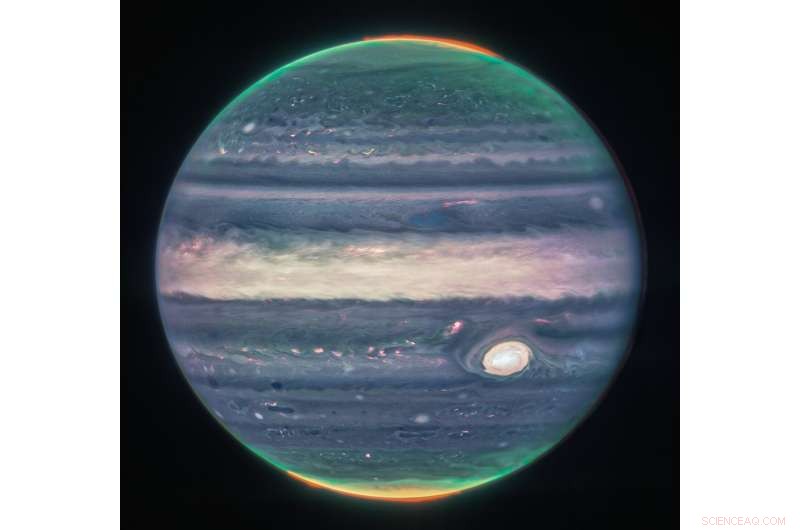
James Webb Space Telescope-billeder af Jupiter viser en fantastisk rigdom af detaljer. Et filter, der er følsomt over for nordlysemission fra ioniseret brint (kortlagt i den røde kanal) afslører nordlysovaler på planetens skive, der strækker sig til store højder over både den nordlige og sydlige pol. Et andet filter, der er følsomt over for dis i høje højder (kortlagt i den grønne kanal) fremhæver de polære diser, der hvirvler rundt om den nordlige og sydlige pol, mens et tredje filter fremhæver lys reflekteret fra den dybere hovedsky (kortlagt i den blå kanal). Den store røde plet, ækvatorialområdet og kompakte (inklusive bittesmå) skyområder fremstår hvide (eller rødlig-hvide) i dette falske farvebillede. Områder med lidt skydække fremstår som mørke bånd nord for ækvatorialområdet. Andre mørke områder her, både ved siden af Den Store Røde Plet og i cykloniske træk på den sydlige halvkugle, er også mørkefarvede, når de observeres i synligt lys. Kredit:NASA, European Space Agency, Jupiter Early Release Science-team. Billedbehandling:Judy Schmidt
De seneste billeder af Jupiter fra James Webb Space Telescope (JWST) er fantastiske.
Optaget den 27. juli viser de infrarøde billeder – kunstigt farvet for at få specifikke træk til at skille sig ud – fin filigran langs kanterne af de farvede bånd og rundt om Den Store Røde Plet og giver også en hidtil uset udsigt over nordlyset over nord- og sydpolen.
Ét bredfeltsbillede viser en unik opstilling af planeten, dens svage ringe og to af Jupiters mindre satellitter - Amalthea og Adrastea - mod en baggrund af galakser.
"Vi har aldrig set Jupiter sådan her. Det hele er ganske utroligt," sagde planetarisk astronom Imke de Pater, professor emerita fra University of California, Berkeley, som ledede de videnskabelige observationer af planeten sammen med Thierry Fouchet, en professor ved Paris Observatorium. "Vi havde egentlig ikke forventet, at det ville være så godt, for at være ærlig. Det er virkelig bemærkelsesværdigt, at vi kan se detaljer om Jupiter sammen med dens ringe, bittesmå satellitter og endda galakser på ét billede."
De Pater, Fouchet og deres team frigav billederne i dag (22. august) som en del af teleskopets Early Release Science-program.
-
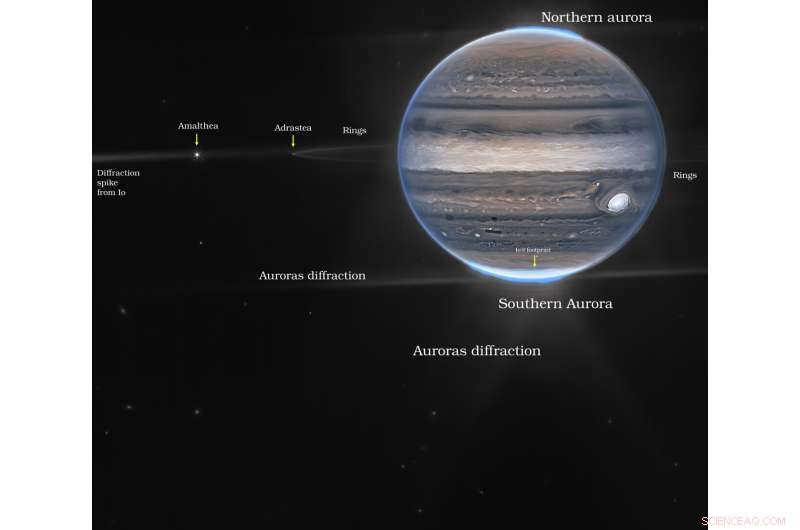
Dette falske farvesammensatte billede af Jupiter blev opnået med NIRCam-instrumentet om bord på James Webb-rumteleskopet den 27. juli 2022. Det brede farveskema adskiller sig fra farvesammensætningen, fordi denne billedbehandlingstilstand brugte forskellige eksponeringstider og kun to filtre, kortlagt i orange og cyan farver. Billedet viser Jupiters ringe og nogle af dens små satellitter sammen med baggrundsgalakser. Amalthea (~250 x 150 km på tværs) og lille Adrastea (~20 km på tværs) er synlige på dette billede. Diffraktionsmønsteret skabt af de lyse nordlys, såvel som månen Io (lige ude til venstre, ikke synlig på billedet), danner en kompleks baggrund af spredt lys omkring Jupiter. Credit:NASA, European Space Agency, Jupiter Early Release Science team. Image processing:Ricardo Hueso [UPV/EHU] and Judy Schmidt
-
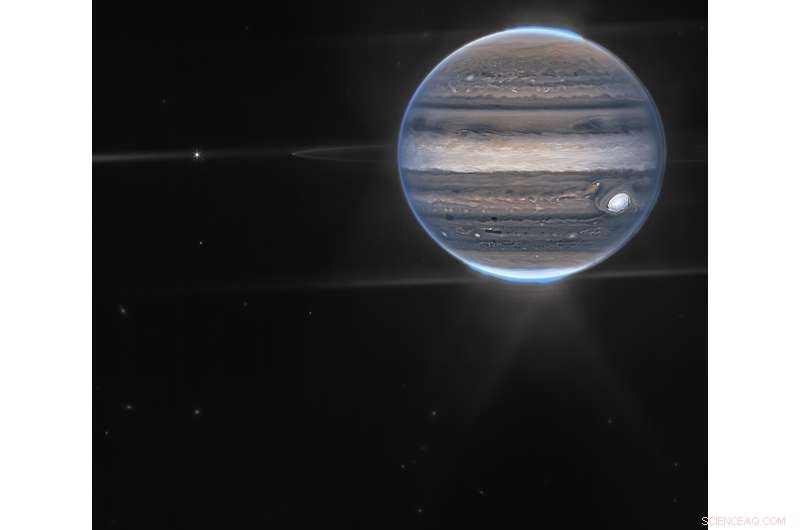
This false color composite image of Jupiter was obtained with James Webb Space Telescope's NIRCam instrument on July 27, 2022. A combination of short and long exposures in F212N (mapped to an orange color) and F335M (mapped to cyan) show Jupiter's rings and some of its small satellites together with background galaxies. Amalthea (~250 x 150 km across) and tiny Adrastea (~20 km across) are visible in this image. The diffraction pattern created by the bright auroras, as well as the moon Io (just off to the left, not visible in the image), form a complex background of scattered light around Jupiter. Credit:NASA, European Space Agency, Jupiter Early Release Science team. Image processing:Ricardo Hueso [UPV/EHU] and Judy Schmidt
In addition to the enormous storm referred to as the Great Red Spot, numerous storm systems—seen as small pallid ovals —are also visible, as are tiny bright plumes of cloud particles. The transition between organized zonal flows and the chaotic vortex patterns at higher latitudes is also clearly visible.
"Although we have seen many of these features on Jupiter before, JWST's infrared wavelengths give us a new perspective," said de Pater. "JWST's combination of images and spectra at near- and mid-infrared wavelengths will allow us to study the interplay of dynamics, chemistry and temperature structure in and above the Great Red Spot and the auroral regions."
Amalthea and Adrastea
JWST's Near Infrared Camera (NIRCam) also captured a wide-field view of Jupiter revealing its rings and two of its moons.
"This image illustrates the sensitivity and dynamic range of JWST's NIRCam instrument," Fouchet said. "It reveals the bright waves, swirls and vortices in Jupiter's atmosphere and simultaneously captures the dark ring system, 1 million times fainter than the planet, as well as the moons Amalthea and Adrastea, which are roughly 200 and 20 kilometers across, respectively. This one image sums up the science of our Jupiter system program, which studies the dynamics and chemistry of Jupiter itself, its rings and its satellite system."
The JWST images were processed with the help of citizen scientist Judy Schmidt of Modesto, California, who has worked with Hubble Space Telescope and other telescope images for the past 10 years, and Ricardo Hueso, who studies planetary atmospheres at the University of the Basque Country in Spain. Hueso is one of several coinvestigators on the Early Release Science (ERS) program, and is leading the NIRCam observations of Jupiter's atmosphere.
Schmidt's love of astronomy images has led her to process images of nebulae, globular clusters, stellar nurseries and more spectacular cosmic objects.
"Something about it just stuck with me, and I can't stop. I could spend hours and hours every day," she said. Her goal, she added, is to "… try to get it to look natural, even if it's not anything close to what your eye can see."
Spectroscopic observations of Jupiter's auroras are scheduled for later this year, while detailed spectroscopic observations of Jupiter's Great Red Spot were taken on July 27 in the near-infrared and August 14-15 at mid-infrared wavelengths. The Great Red Spot observations are a joint project between the Early Release Science (ERS) team—with de Pater and Fouchet as co-principal investigators—and a program of Solar System observations developed by Heidi Hammel of the Association of Universities for Research in Astronomy (AURA), with the Jupiter observations led by Leigh Fletcher, a professor at the University of Leicester in England.
Other UC Berkeley members of the ERS team for Jupiter observations are research astronomer Mike Wong and postdoctoral fellow Ned Molter. + Udforsk yderligere
NASA releases Webb images of Jupiter
 Varme artikler
Varme artikler
-
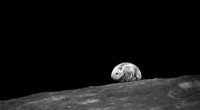 Leder du efter stykker af Venus? Prøv månenKredit:CC0 Public Domain En voksende mængde forskning tyder på, at planeten Venus kan have haft et jordlignende miljø for milliarder af år siden, med vand og en tynd atmosfære. Alligevel er det v
Leder du efter stykker af Venus? Prøv månenKredit:CC0 Public Domain En voksende mængde forskning tyder på, at planeten Venus kan have haft et jordlignende miljø for milliarder af år siden, med vand og en tynd atmosfære. Alligevel er det v -
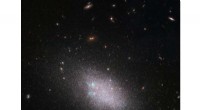 Billede:Hubble får øje på en sværm af stjernerKredit:ESA/Hubble &NASA; LEGUS teamet, B. Tully, D. Calzetti; Anerkendelse:Judy Schmidt (Geckzilla) Dette billede fra NASA/ESA Hubble-rumteleskopet viser en dværggalakse ved navn UGC 685. Sådanne
Billede:Hubble får øje på en sværm af stjernerKredit:ESA/Hubble &NASA; LEGUS teamet, B. Tully, D. Calzetti; Anerkendelse:Judy Schmidt (Geckzilla) Dette billede fra NASA/ESA Hubble-rumteleskopet viser en dværggalakse ved navn UGC 685. Sådanne -
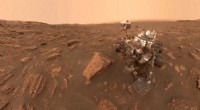 Curiosity rover finder pletter af rockplade slettet, afslørende sporEt selvportræt af NASAs Curiosity rover taget på Sol 2082 (15. juni, 2018). En støvstorm fra Mars har reduceret sollys og synlighed ved roverens placering i Gale Crater. Kredit:Jet Propulsion Laborato
Curiosity rover finder pletter af rockplade slettet, afslørende sporEt selvportræt af NASAs Curiosity rover taget på Sol 2082 (15. juni, 2018). En støvstorm fra Mars har reduceret sollys og synlighed ved roverens placering i Gale Crater. Kredit:Jet Propulsion Laborato -
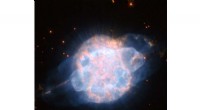 Et gennemtrængende himmelsk øje stirrer tilbage på HubbleKredit:ESA/Hubble og NASA Dette dramatiske billede fra NASA/ESA Hubble-rumteleskopet viser den planetariske tåge NGC 3918, en strålende sky af farverig gas i stjernebilledet Centaurus, omkring 4,
Et gennemtrængende himmelsk øje stirrer tilbage på HubbleKredit:ESA/Hubble og NASA Dette dramatiske billede fra NASA/ESA Hubble-rumteleskopet viser den planetariske tåge NGC 3918, en strålende sky af farverig gas i stjernebilledet Centaurus, omkring 4,
- Et bedre skøn over vandstandsstigningen i Ganges-deltaet
- Designet af W7-X fusionsenheden gør det muligt at overvinde forhindringer, finder forskere
- Polymerbevægelse:nøglen til næste generation af belægninger
- Amazon, Google accepterer at tillade hinanden at streame apps
- Hvordan vulkaner eksploderer i dybhavet
- Forskere udvikler et lægemiddelleveringssystem ved hjælp af nanopartikler udløst af elektromagnet…


